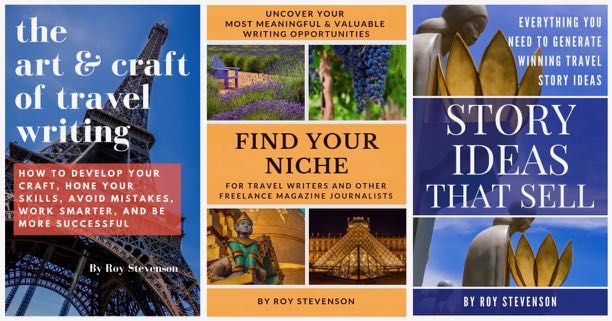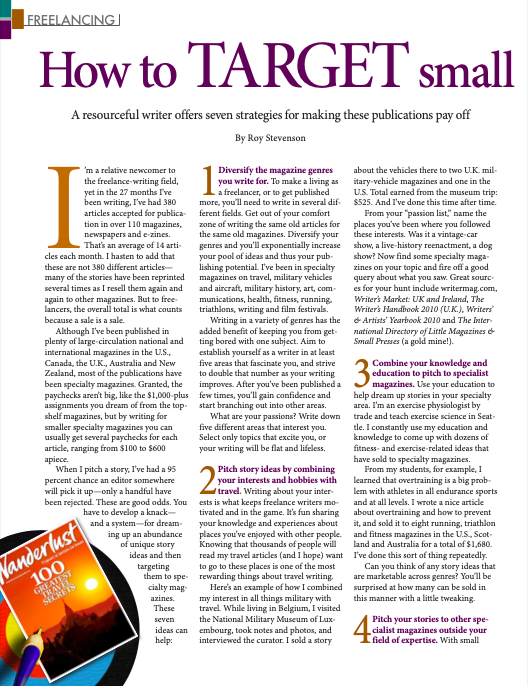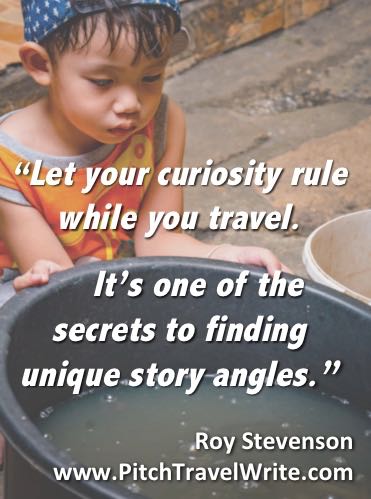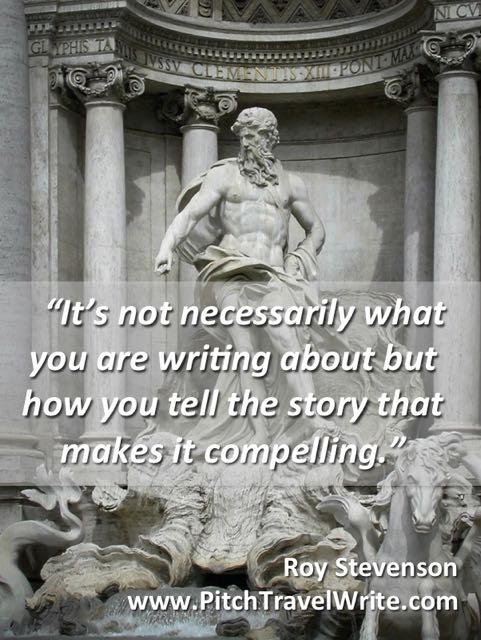- Home
- Travel Writing Craft Resources
- Creating a Sense of Place
Creating a Sense of Place
in Your
Travel Articles
By Roy Stevenson
The essence of good travel writing is to give your readers a sense of place by revealing its ambiance as if they were there, experiencing it. The trick is to write imaginatively enough to paint pictures with your words.
Most people read travel articles as a form of escapism. So your words need to be easy to follow and your descriptions succinct. People don't want to work hard reading your stories. Your readers want to feel the atmosphere of a place without choking on overused or nondescript words.
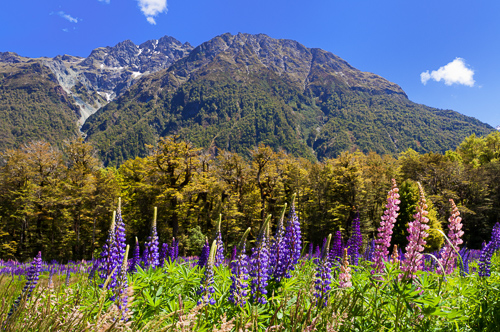 How would you describe this scene to make a reader feel like they are there?
How would you describe this scene to make a reader feel like they are there?There are a few techniques that are particularly effective in helping your reader feel a sense of place, and they all have to do with carefully choosing your words.
Here are two things to do - and two things not to do - to do to make your articles more unique and enjoyable for your readers:
Helping the Reader Feel a Sense of Place
Pick up any travel magazine and read through the descriptions of the places in the stories. Do the descriptions take you there? Can you imagine being in the place just by reading the description? Can you feel the heat, hear the sounds, or imagine the scenery?
Here are three good examples from my travel articles. Read them and see how these descriptions manage to give the reader a sense of place:
From my article about Queenstown, New Zealand, in Australia & New Zealand Magazine: “The sweeping view across the Glenorchy basin can’t be absorbed in a quick glance. Beyond Diamond Lake in the foreground, lush green farmland meanders across the valley, dotted with white specks of sheep and rows of jagged tooth massifs in the distance.”
Another paragraph from the same article: “Further on, pink and magenta lupines provide a curtain of bright color against the green marshlands and a gray mountain backdrop.”
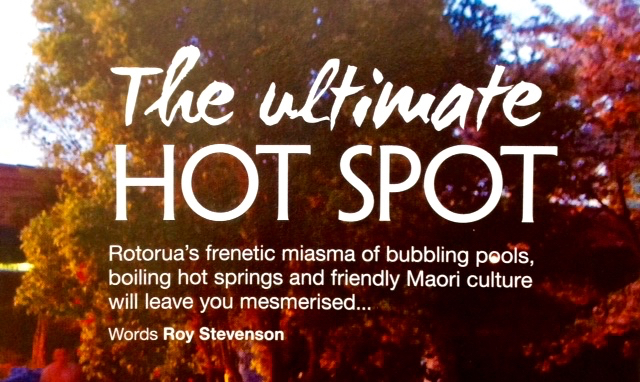
Here’s a description from my article about Rotorua, New Zealand, also in Australia & New Zealand Magazine:
“Moving on, I walk along white gravel pathways that meander past scenes
from what I would imagine hell to be like. Billowing clouds of hot
steam and mist escape from jagged rents in the earth’s narrow crust. An
overpowering smell of sulphur assaults my nose, while plumes of white
geysers erupt from boreholes in the barren rock”.
Taking the
time to describe a scene is important to creating a sense of place and
ambiance in your stories. Deciding which words to use is an important
part of developing as a travel writer.
Ditch the Clichés
It takes some time to dig deeply and express what you experienced in a place. Often we get lazy and utilize overused phrases, or clichés, instead of working a little harder when choosing our words.
The use of clichés can reduce your story from an absorbing read to a hackneyed piece of limp lettuce in a few agonizing paragraphs.
Here are a few clichés I’ve seen a few times too many:
“Snow-capped mountains”, “sparkling blue water”, “green and verdant parks”, “steamy jungles”, "charming xxx", "quaint village",“pristine beaches”, “a kaleidoscope of colors”, “seething masses of humanity”, “bustling markets”, “twisting alleys”, “a land of contrasts”, “half-forgotten byways”, “where old meets new”, “et cetera”. (Yes, et cetera is also a cliché!)
There are plenty more travel clichés like these, and I’m sure you’ve seen them all at one time or another.
We tend to use clichés as a fallback when we’re facing tight deadlines or we’re feeling tired. We’re all guilty of using them from time to time. The challenge as a writer is to use them as little as possible.
(You can look up commonly used clichés online. Just do a search for "travel cliches" to get started.)
When you notice clichés creeping into your stories, it’s time to actively search for new ways to describe your scenes. For unique stories that make your readers feel a sense of place, ditch the clichés.
Remove Flat Adjectives
One of the cliché’s close cousins is “flat adjectives”. Often we interject these into stories as a form of travel writer’s shorthand, but they contribute little to our story.
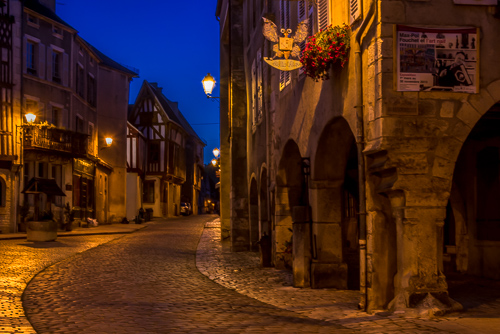 "When we strolled into the tiny cobblestone village, it appeared to be deserted. Only the church bell, tolling its melancholy tones every hour, suggested that people still live here.”
"When we strolled into the tiny cobblestone village, it appeared to be deserted. Only the church bell, tolling its melancholy tones every hour, suggested that people still live here.”At first glance, words like magnificent, wonderful, spectacular, beautiful, charming, quaint, nice, fine, cheap, and fabled seem to work when describing a place.
But when you stop and think about these words, you realize these words are ambiguous. They’re subject to all sorts of personal interpretations.
What is “quaint” to one person may be tacky to another. What is “beautiful” to one reader may be boring to another. What is “a reasonable rate” to someone is overpriced to another.
Choose your descriptive words carefully. Describe what you mean by “spectacular” without actually using the word. This lets the reader draw his own conclusions from your descriptions.
Here’s a paragraph that conveys a feeling of isolation and quiet without using those words. “When we strolled into the tiny cobblestone village, it appeared to be deserted. Only the church bell, tolling its melancholy tones every hour, suggested that people still live here”.
Instead of describing a bay as “beautiful”, show the reader what makes it beautiful. “The long, sweeping bay of dazzling white sand, punctuated by towering blue waves, seems to go on forever. Bent palms and coconut trees recede up the shoreline, with nary a human to be seen”. This description may seem like overkill, and maybe it is, but it gives the reader a lot more information than “beautiful”.
Write to the Senses and Other Stimuli
One of the most powerful, yet neglected, travel writing techniques is that of appealing to the senses - all of the senses.
Most of us do a reasonable job describing what we see, but we neglect our other senses (touch, smell, sound, taste).
Our sense of smell is particularly powerful and conjures up powerful images in our minds. Smell is the most sensitive of our senses, and people can remember smells with 65% accuracy after a year, while visual recall is only about 50% accurate after only three months.
Any time you can convey smells or aromas in your travel stories, do it to more powerfully convey a sense of place.
There are also many other stimuli in addition to our traditional senses that you can use to describe a place, such as temperature, balance, speed, time and pain. The effect of using your senses to describe a place is potent.
When you are writing a description of a place, think in terms of which of your senses you experienced while you were there. Close your eyes and envision being there again. What did you hear? How did you feel? What did you smell? What did you taste? What sensations did you feel?
Just to get you started, here are some examples of using your senses to create descriptions - and a sense of place - for your readers:
• The spicy aroma of food sizzling in the pan
• The complex swirl of fruit and spices inside your mouth
• The shocking sensation of a hot curry on your tongue
• The fragrant scent of jasmine in the garden air
• The salty scent of seaside air (or other smells like seaweed and fish)
• The organic smell of newly cut timber
• The synthetic smell of new plastic seats in a classic car
• The musical cacophony of bird sounds in the morning
• The overlapping sounds of croaking frogs
• The chaotic sounds of endless traffic at a busy intersection
• The eerie sound of a foghorn
• The rough feel of sandpaper (or the feel of other textures)
• The sticky feel of humidity on your skin in the tropical heat
• The acrid taste of polluted air
Any time you think your writing isn’t as expressive as it needs to be, use these techniques to amp it up. It won’t take long before describing a sense of place becomes part of your natural writing style. Your readers will feel the ambiance and love you for it.
Break into Travel Writing
with the Creative Pack
The Creative Pack includes 3 eBooks that are the starting point for every travel writer: dreaming up unique story ideas that you can sell, finding the best writing niches for you based on your interests, passions and experience, and the art & craft of travel writing. They’re the pieces of the puzzle that come before you ever write a query letter to sell your articles to magazine editors.
If you're just getting started in travel writing, this group of resources will help you improve your craft, generate story ideas that sell, and develop your own unique and meaningful niche.
These eBooks can be purchased separately, but when you buy the bundle you'll save more than 10% off individual prices! Learn more here ...
Other articles that will interest you:
Your Travel Writing Craft Resource Page
Nine Ways to Beef Up Your Travel Stories
Six Ways to Get Useful Feedback and Improve Your Writing
Seven Ways to Improve Your Writing Style

Roy Stevenson is a professional travel writer and the author of www.PitchTravelWrite.com. Over the past ten years, he’s had more than 1000 articles published in 200 magazines, trade and specialty journals, in-flights, on-boards, blogs and websites and has traveled on assignment around the U.S. and to dozens of international destinations.
IF YOU ENJOYED THIS POST, GET UPDATES. IT'S FREE.
